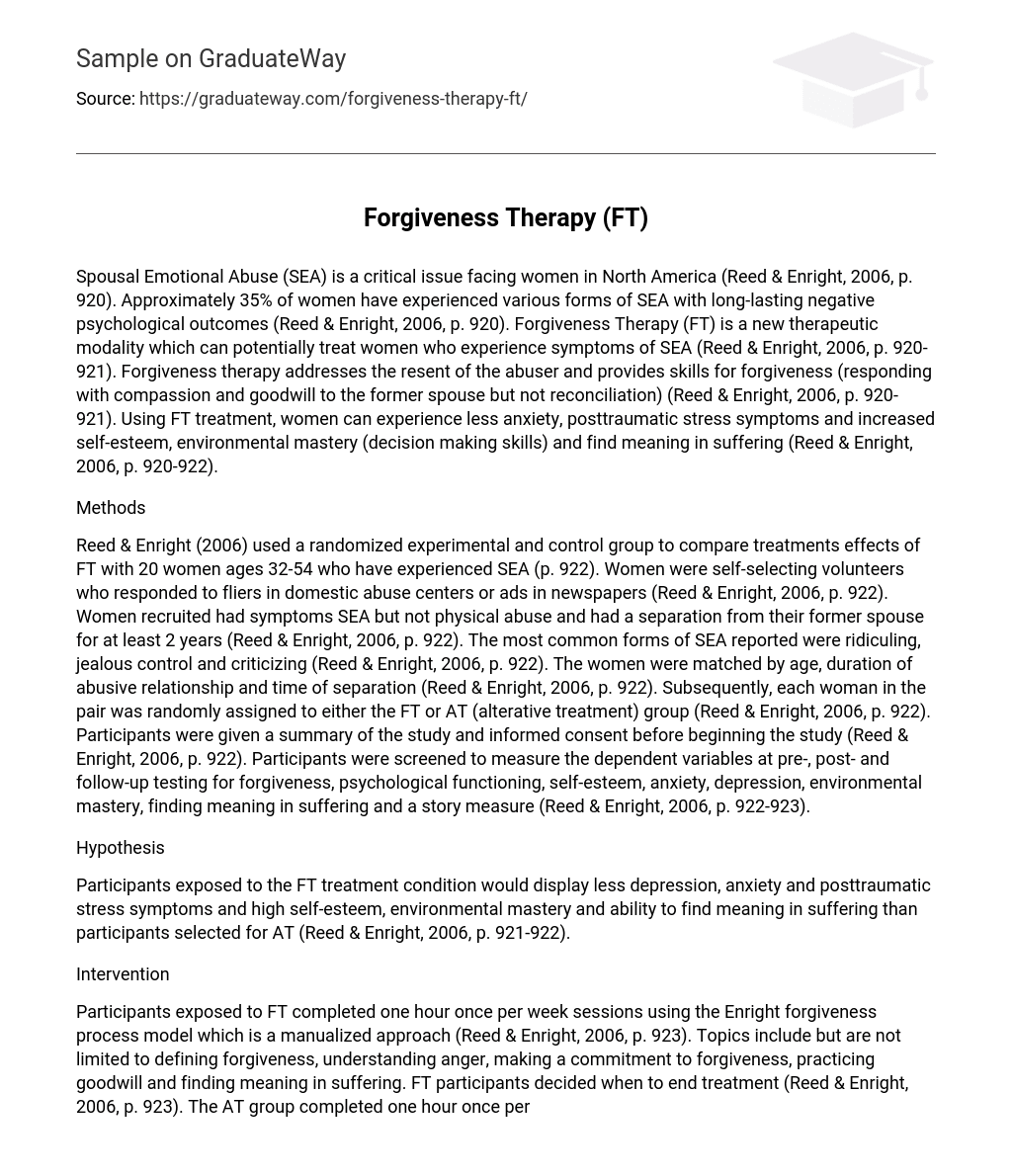Spousal Emotional Abuse (SEA) is a critical issue facing women in North America (Reed & Enright, 2006, p. 920). Approximately 35% of women have experienced various forms of SEA with long-lasting negative psychological outcomes (Reed & Enright, 2006, p. 920). Forgiveness Therapy (FT) is a new therapeutic modality which can potentially treat women who experience symptoms of SEA (Reed & Enright, 2006, p. 920-921). Forgiveness therapy addresses the resent of the abuser and provides skills for forgiveness (responding with compassion and goodwill to the former spouse but not reconciliation) (Reed & Enright, 2006, p. 920-921). Using FT treatment, women can experience less anxiety, posttraumatic stress symptoms and increased self-esteem, environmental mastery (decision making skills) and find meaning in suffering (Reed & Enright, 2006, p. 920-922).
Methods
Reed & Enright (2006) used a randomized experimental and control group to compare treatments effects of FT with 20 women ages 32-54 who have experienced SEA (p. 922). Women were self-selecting volunteers who responded to fliers in domestic abuse centers or ads in newspapers (Reed & Enright, 2006, p. 922). Women recruited had symptoms SEA but not physical abuse and had a separation from their former spouse for at least 2 years (Reed & Enright, 2006, p. 922). The most common forms of SEA reported were ridiculing, jealous control and criticizing (Reed & Enright, 2006, p. 922). The women were matched by age, duration of abusive relationship and time of separation (Reed & Enright, 2006, p. 922). Subsequently, each woman in the pair was randomly assigned to either the FT or AT (alterative treatment) group (Reed & Enright, 2006, p. 922). Participants were given a summary of the study and informed consent before beginning the study (Reed & Enright, 2006, p. 922). Participants were screened to measure the dependent variables at pre-, post- and follow-up testing for forgiveness, psychological functioning, self-esteem, anxiety, depression, environmental mastery, finding meaning in suffering and a story measure (Reed & Enright, 2006, p. 922-923).
Hypothesis
Participants exposed to the FT treatment condition would display less depression, anxiety and posttraumatic stress symptoms and high self-esteem, environmental mastery and ability to find meaning in suffering than participants selected for AT (Reed & Enright, 2006, p. 921-922).
Intervention
Participants exposed to FT completed one hour once per week sessions using the Enright forgiveness process model which is a manualized approach (Reed & Enright, 2006, p. 923). Topics include but are not limited to defining forgiveness, understanding anger, making a commitment to forgiveness, practicing goodwill and finding meaning in suffering. FT participants decided when to end treatment (Reed & Enright, 2006, p. 923). The AT group completed one hour once per week sessions which participants led discussions with an intervenor regarding the impact of abuse, validation of anger, strategies for making assertive choices and interpersonal skills (Reed & Enright, 2006, p. 923). AT participants also decided the amount of time to spend on each topic to remain a matched control group to FT (Reed & Enright, 2006, p. 923). Both the FT and AT groups had a psychiatric nurse as an intervenor (Reed & Enright, 2006, p. 923-924). The intervenor used restating, paraphrasing, summarizing and open questions. Treatment for both groups lasted an average of 8 months (range 5-12 months) (Reed & Enright, 2006, p. 923-924).





